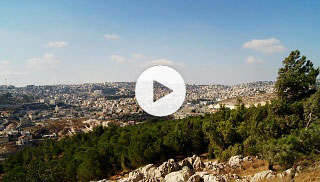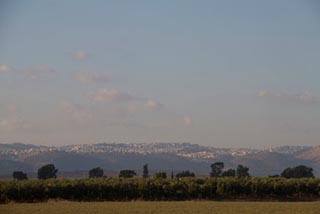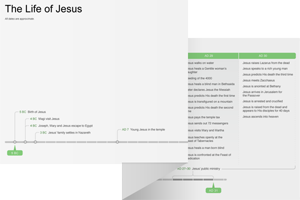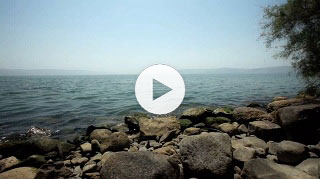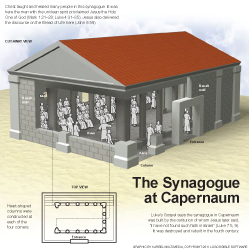1:1–8 Mark |
1:1 gospel The Greek word used here, euangelion (“gospel” or “good news”), eventually came to describe the genre of the first four books of the nt; but Mark probably uses it to describe the content of the Christian message (compare 1 Cor 15:1). Mark 1:1 introduces the good news concerning the person, teaching, and life of Jesus, God’s Son (see vv. 14–15).
Jesus The name iēsous (Jesus) is the Greek version of the Hebrew name Joshua (yehoshua' or yeshua'), a common Jewish name in the first century ad.
Christ The Greek word used here, christos, translates the Hebrew title mashiach, meaning “anointed one.” The term often functions as part of Jesus’ name, though elsewhere it is used as a title (e.g., 8:29; 12:35; 14:61).
1:2 it is written A conventional formula used for introducing a biblical quotation.
prophet The term prophētēs refers to someone God calls, designates, appoints, or commissions for a specified task (usually involving delivery of a message).
prophētēs refers to someone God calls, designates, appoints, or commissions for a specified task (usually involving delivery of a message).
Isaiah Though only Isaiah is mentioned by name, Mark conflates Mal 3:1 and Isa 40:3 into one quotation—mixing traditions from various Scripture texts was common at the time (e.g., 2 Cor 6:14–7:1).
who will prepare In addition to resembling Mal 3:1, Mark’s quotation echoes Exod 23:20, where an angel is described as protecting God’s people during their wilderness journey and fighting on their behalf (Exod 23:21–23). The people are commanded to listen to this angel and not rebel against him. Likewise, John the Baptist presents the very truths of God and acts as the advocate for God’s ministry in Jesus.
1:3 the wilderness The Greek word used here, erēmos, describes an uncultivated or unpopulated region. In the Bible, the term often refers to the arid expanses south and east of Judah. See note on Matt 3:1.
way The Greek word used here, hodos, often refers to a road or path. Mark uses it predominantly to describe a journey. Mark often describes Jesus’ journey to Jerusalem as the “way” that He undertakes in obedience to God, fully aware it will lead to suffering and death (Mark 8:27; 9:33–34; 10:17, 32, 46, 52).
make straight his paths The cry of a herald who runs in advance of a king announcing his imminent arrival—the king in Isa 40:3, being quoted here, is God Himself. In Mark’s Gospel, the herald is John the Baptist, who announces Jesus’ arrival and the kingdom of God (Mark 1:4–8).
1:4 John See note on John 1:6.
baptism of repentance In ancient Israel, water was often used as an instrument for purification (e.g., Lev 17:15; 22:4–6; Num 19:11–12). As a result, baptism in Judaism often was about ritual cleansing and may have involved multiple and regular baptisms. By contrast, John’s baptism stressed transformation—a turning from sin—and thus marked a turning point in a person’s life.
 Aphesis Word Study
Aphesis Word Study
for the forgiveness of sins John points to Jesus’ greater ministry, even calling Him the Lamb of God who takes away the sin of the world (John 1:29–31). John’s baptism was about forgiveness of sins in the sense that it pointed to Jesus, who was the means of providing that forgiveness.
1:5 Jordan River After 40 years of wandering in the wilderness, the Israelites crossed the Jordan to take possession of the promised land (Josh 3). The river carried symbolic connotations of national renewal and the fulfillment of God’s work among them. It is at this location that John the Baptist inaugurates the way for spiritual renewal. See note on Matt 3:6.
1:6 camel’s hair and a belt made of leather John’s ministry is associated with Elijah, one of Israel’s greatest prophets (Mark 6:14–16; 9:11–14; Matt 11:14). Elijah is characteristically described as wearing garments of hair and a leather belt (2 Kgs 1:8).
ate locusts and wild honey See note on Matt 3:4.
1:7 One who is more powerful than I John understands himself to be the forerunner of the Messiah (compare Mark 1:2–3).
I am not worthy Removing and carrying sandals was the work of slaves. John is stating that he is not worthy even to be a slave of the Messiah (the anointed one of God).
1:8 baptized you with water John’s baptism was in preparation for the Messiah, through whom God would pour out His Spirit on the people of Israel (Joel 2:28; Isa 32:15; 44:3; Ezek 36:26; compare Isa 42:1). John anticipates that Jesus’ appearance would directly precede the arrival of God’s Spirit (compare Acts 2:1–13).
1:9–11 Jesus’ baptism links his future ministry to John’s program of national transformation and renewal. It also serves as a commissioning scene, identifying Jesus as the primary subject of the prophecy quoted in Mark 1:2–3. |
1:9 from Nazareth A small town in Galilee. Jesus seems to have spent the majority of His childhood and youth years, and perhaps His early adulthood, in Nazareth (Matt 2:23; Luke 4:16). He does not begin His adult ministry until around age 30 (Luke 3:23).
Galilee The northernmost region of Palestine. After the death of Herod the Great in 4 bc, his son, Antipas, administered Galilee
administered Galilee (along with Perea, where John was baptizing). See note on Luke 3:1.
(along with Perea, where John was baptizing). See note on Luke 3:1.
1:10 heavens being split apart Evokes the language of Isa 64:1–2. Isaiah 64 is about the awesome arrival of God’s presence and the need for sinful people to be saved; the passage has in view both the Jewish people and the nations (the entire world). In culmination of Isa 64, Jesus’ baptism marks the arrival of God’s presence (compare Mark 1:15).
Spirit This connects Jesus to Isa 42:1, where God states that He will put His Spirit on His Servant. It portrays Jesus as the anointed Servant in Isaiah who is commissioned by God to establish justice on the earth (Isa 42:1, 4).
 Pneuma Word Study
Pneuma Word Study
1:11 You are my beloved Son Drawn from Psa 2:7. Psalm 2 speaks about the role of the anointed one of Yahweh (the Messiah) and how the kings of the earth should fear Yahweh and His Son, for all nations will ultimately be His heritage (Psa 2:7, 11–12; compare Isa 52:15; 53:12).
1:12–13 Having commissioned Jesus, the Spirit now exposes Jesus to a period of testing by Satan, preparing Him for the task ahead. |
1:12 into the wilderness See note on Luke 4:1.
1:13 forty days Suggests a deliberate parallel between Jesus’ testing and Israel’s 40 years of wandering in the wilderness, which also involved testing (Deut 2:7; 8:1–18).
being tempted by Satan Satan is called the devil in the other Gospel accounts of this event (Matt 4:1; Luke 4:2). In the ot, Satan is portrayed as an accuser and as a figure who is part of God’s council operating in a limited role (see Job 1:6 and note; Zech 3:2). By the time of Mark’s Gospel, Satan is understood as a renegade spiritual figure who is openly opposing God’s will and has considerable evil power in the present age (2 Cor 4:4).
1:14–15 As soon as John the Baptist is arrested, Jesus emerges from the wilderness to declare the arrival of God’s kingdom on earth. |
1:15 time In this context, the Greek word used here, kairos, indicates a period of time predetermined by God.
kingdom The Greek word used here, basileia, can denote a geographical territory or the reign of a particular monarch. The kingdom of God refers to God’s reign over all of creation and humanity. Jesus’ teaching in Mark reveals that members of the kingdom of God are marked by childlike humility (Mark 9:33–37; 10:13–16), concern for the poor (10:21–31), sacrificial service (10:42–45), and love for God and neighbor (12:28–34). The language Mark uses to describe God’s rule demonstrates its dynamic character: The kingdom comes (vv. 15; 9:1; compare 15:43), it grows like a seed (4:26, 30), and people can enter it, but only by responding to God’s will (9:47; 10:15, 23–25; 12:34).
 The Kingdom of God: Already but Not Yet
The Kingdom of God: Already but Not Yet
has come near There are obvious examples in history before this time of Yahweh reigning on earth, such as when Israel was established in the promised land or when Yahweh’s temple was built in Jerusalem. However, God’s full reign—as seen in the garden of Eden shortly after creation—had not existed since sin entered the world (Gen 2:4–9, 3; compare Rev 22:1–5). Jesus’ proclamation suggests that the time of God’s full reign on earth is near.
believe in the gospel Since Jesus announces the advent of a new kingdom, belief in the gospel entails allegiance to the new king, Jesus.
1:16–21 Jesus begins to call individual disciples. |
1:16 Sea of Galilee A lake fed by the Jordan
fed by the Jordan River; it forms the eastern boundary of the region of Galilee.
River; it forms the eastern boundary of the region of Galilee. Much of Jesus’ ministry takes place along its western shores. Jesus will cross it in order to expand His ministry into the regions east and north of it (Mark 4:35; 5:1; 6:45).
Much of Jesus’ ministry takes place along its western shores. Jesus will cross it in order to expand His ministry into the regions east and north of it (Mark 4:35; 5:1; 6:45).
Simon Jesus will rename him Peter (3:16). In addition to being Jesus’ first disciple named in Mark, Simon will be the first person in Mark’s Gospel to recognize Jesus as the Messiah (8:29).
Andrew Jews at this time often had Greek rather than Hebrew or Aramaic names.
1:17 Follow me Jesus as rabbi calls His first disciples using a phrase that evokes ot images of prophetic succession (1 Kgs 19:20; compare Mark 9:5; 11:21). Jesus’ call also is a reminder that He is on a journey that has been prepared for Him (vv. 2–3).
1:18 And immediately they left their nets and followed The immediacy of their response conveys the urgency of Jesus’ message about the kingdom of God and the level of commitment that it requires (compare 10:28).
1:19 James the son of Zebedee One of the first disciples and a member of Jesus’ inner group of disciples; not to be confused with James the brother of Jesus.
John One of the first disciples and a member of Jesus’ inner circle.
1:20 hired men The Greek word misthōtos indicates a wage-laborer. These men, who have no commitment to Zebedee beyond the wages he pays them, remain in his employment; Zebedee’s own sons, whose natural loyalty is to their father, immediately drop that allegiance and transfer it to Jesus. This motif resurfaces in Mark 10:29–30.
1:21–28 Jesus demonstrates the kingdom’s presence in His amazing teaching and in his ability to perform an exorcism, which verifies His authority. |
 Miracles of Jesus Table
Miracles of Jesus Table
1:21 Capernaum A village on the northern shore of the Sea of Galilee.
on the northern shore of the Sea of Galilee.
Sabbath The traditional day of rest for the Jewish people as prescribed by the law (Exod 20:8–11; Deut 5:12–15).
synagogue See note on Matt 4:23.
1:22 scribes Refers to experts in the law of Moses. They served a religious function alongside the priests and Pharisees.
1:23 an unclean spirit The term used here links the idea of malevolent supernatural forces to the Jewish concern for purity and holiness.
cried out Refers to the man with the unclean spirit. His next words, however, indicate that the unclean spirit is actually speaking through him, since a plural (“us”) is used.
1:24 I know who you are So far in Mark’s Gospel, only Jesus seems to know His true identity (Mark 1:11). Mark emphasizes the demons’ recognition of Jesus as the one God has set apart for a purpose. This highlights both human ignorance of who Jesus is and how fearful evil powers were of Him.
1:25 Be silent With this command, Jesus simultaneously neutralizes the spirit’s attempt to oppose Him and prevents His identity as the Messiah from becoming public knowledge (see v. 24 and note).
1:27 they obey him Exorcists were common in the ancient Near East. For example, among the Dead Sea Scrolls (circa 250 bc–ad 50), a text containing an incantation formula designed to exorcise demons was discovered. Jesus distinguishes Himself from other exorcists in that He did not rely on complex incantations. He could simply command the demons and they would leave their hosts.
1:28–34 Jesus’ inaugural exorcism sets off a chain reaction, as those who hear the good news respond to it. |
1:30 at once The Greek word used here, euthys, occurs more than 40 times in Mark, giving Mark’s Gospel an unrelenting pace.
1:31 raised her up The Greek term used here, egeirō, is used frequently throughout Mark to describe Jesus’ healings (e.g., a paralytic in 2:9, 11–12; a dead girl in 5:41; an epileptic in 9:27). Mark uses the same verb to describe the resurrection of the dead (6:14, 16; 12:26; 14:28; 16:6). This overlap connects Jesus’ resurrection with His ministry; His divine power and purpose enable both.
she began to serve See Matt 8:15 and note.
Jesus Heals Peter’s Mother-in-Law | ||
1:32–34 These specific types of healing that had already taken place in Capernaum—the silencing and exorcism of the unclean spirit (Mark 1:21–28) and the healing of Simon Peter’s mother-in-law (vv. 29–31)—now take place on a larger scale. The multiplication of these types of healing illustrates that God’s rule is advancing. The text implies that after observers viewed Jesus’ initial demonstrations of divine power, they told others. This leads Jesus to perform an increasing number of deeds. |
1:32 when the sun had set Indicates the close of the Sabbath day, after which the prohibition against work ended (v. 21). The townspeople, who observed the law, waited until this moment to bring the sick and demon-possessed people to Jesus (compare 3:1–6).
1:34 did not permit the demons to speak Jesus continues to veil His true identity (compare note on v. 24). Jesus’ true identity so challenged the religious leaders of the time that it led to His execution. Mark’s Gospel notes that Jesus is aware that the unveiling of His true identity, as God’s Son and the Messiah, will lead to His death (2:20; 8:31).
1:35–39 Having completed His work in Capernaum, Jesus expands His ministry to the whole of Galilee, but before doing so, He spends time alone in prayer. Instead of embracing the potential fame He could have in Capernaum (v. 38), Jesus moves on so that He may minister in other places. |
1:40–45 This particular healing story shows the unhindered expansion of God’s rule. |
1:40 a leper The Greek word used here, lepros, identifies a person afflicted by a skin disease. Leviticus categorizes such individuals as ritually unclean and prohibits them from coming in contact with other Israelites during their illness (Lev 13:1–46). See note on Lev 13:1–59; and Matt 8:2 and note.
If you are willing, you are able Jesus already demonstrated His ability to eliminate uncleanness when He expelled the demonic spirit at Capernaum (Mark 1:21–28). Now, a man with a different type of impurity seeks cleansing, and Jesus’ success confirms that God’s rule overcomes all obstacles to health and holiness.
1:41 becoming angry In a few ancient manuscripts, the Greek word splanchnizō, which refers to being moved with pity, replaces the term orgizō, which indicates anger. However, the substitution likely reflects a later change by a copyist, to avoid the difficulty of this verse. Jesus affirms His desire to cleanse the man, indicating He is not upset by the leper’s plea.
touched him Jesus’ physical contact with the leper, followed by His immediate cleansing of him, emphasizes that Jesus’ spirit of holiness is more powerful than the uncleanness generated by the skin disease (compare Lev 13–14). Rather than Jesus becoming unclean, He makes the leper clean.
Jesus Heals a Leper | ||
1:44 say nothing to anyone The first of many such requests that Jesus will make so people do not reveal His identity as the Messiah before the time intended by God (see Mark 5:43; 8:30; 9:9). Most of these requests achieve the opposite effect: Instead of staying silent, the people broadcast what He has done for them (7:36), forcing Him to go elsewhere to minister.
which Moses commanded Refers to a sequence of two sacrificial offerings God mandated to mark a diseased individual’s healing and reintegration into the community (Lev 14:1–32). Jesus has already cleansed the man. Now, the priest must directly examine him to certify that the source of uncleanness has indeed gone.
1:45 no longer able to enter publicly Probably due to Jesus’ increasing popularity, not opposition.

|
About Faithlife Study BibleFaithlife Study Bible (FSB) is your guide to the ancient world of the Old and New Testaments, with study notes and articles that draw from a wide range of academic research. FSB helps you learn how to think about interpretation methods and issues so that you can gain a deeper understanding of the text. |
| Copyright |
Copyright 2012 Logos Bible Software. |
| Support Info | fsb |
 Loading…
Loading…



